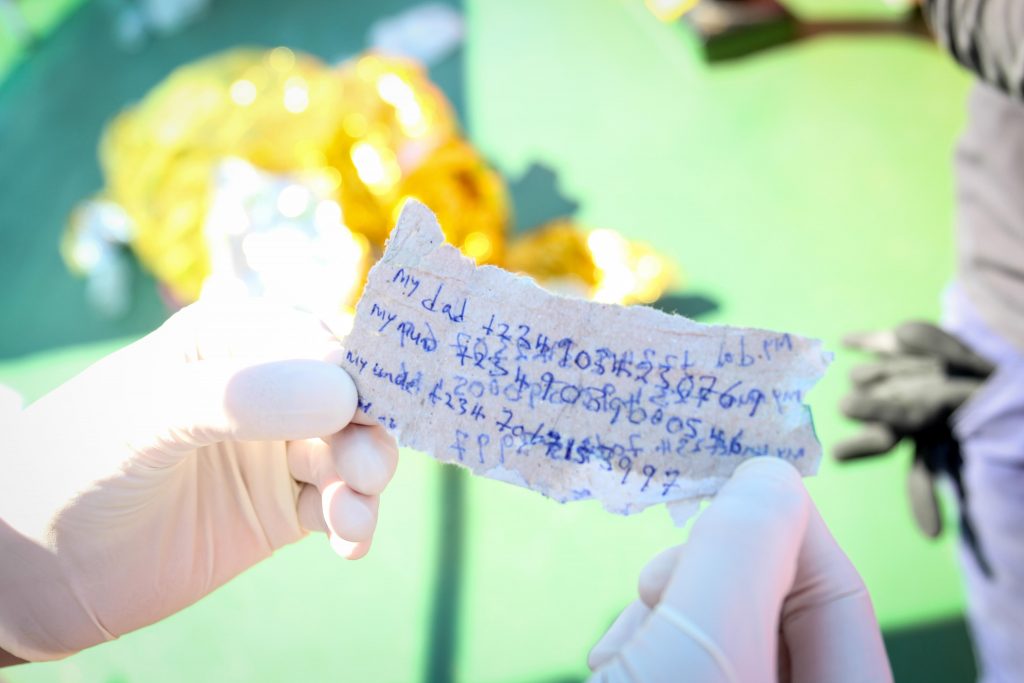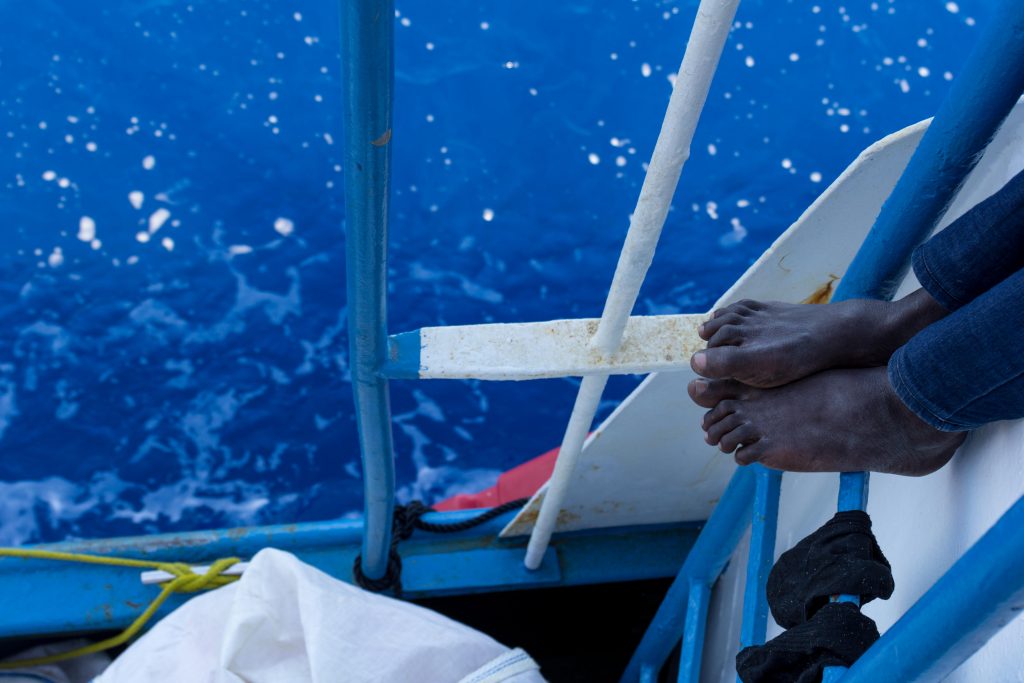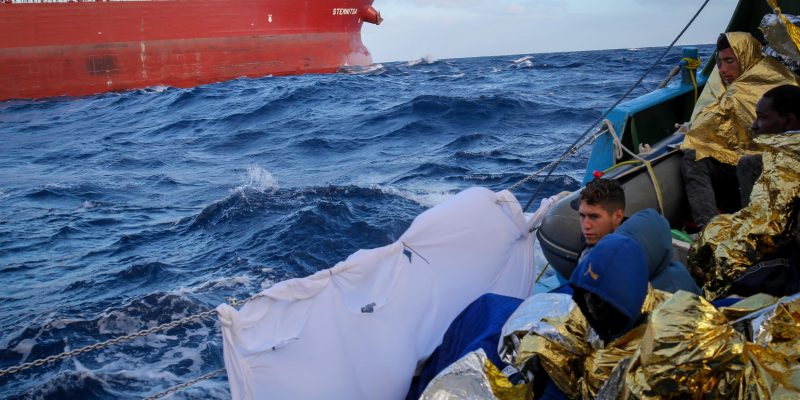10 April 2017, Port of Zarzis, south of Tunisia, near the Libyan border
“The first time I saw a migrant vessel?” Anis, a fisherman from Zarzis, raises his eyebrow. He moves his hand backwards, which means a long, long time ago. “Maybe 2002 or 2003, back when illegal immigration from Libya started.” Tarek Ahmed, who owns a tuna boat, adds: “We’ve found so many corpses – when you see children entangled in your fishing nets… there’s no humanity in that.”
Over the last five days, a lot of boats have been crowding the Port of Zarzis because of a violent storm raging along the coast. Even the NGOs Jugend Rettet, Sea Watch, and MSF have dropped anchor in the small Tunisian harbour for safety reasons. A concerned José Pastor, head of missions on the Iuventa, explains: “No one sails in this weather, but as soon as the sea calms down, there’ll be a lot of boats going out at the same time”. In 2015, after seeing the umpteenth picture of dead bodies in the Mediterranean, a group of Berliners decided to launch a fundraising campaign; they repaired an old fishing boat and founded the NGO Jugend Rettet to begin their missions. “We want to show Europe that if it does nothing to put an end to this slaughter, as normal citizens we will,” says Wilco Holmes, second mate on the Iuventa.
11 April 2017, first day at sea on the Sebastian Kurz Mission
(named after the Austrian politician who accused private NGOs of collaborating with smugglers in March 2017)
Zarzis wakes up with the sun and comes back to life while our boat gets ready to sail. That same night the Libyan Coast Guard announces that a rubber dinghy has sunk within the 12 nautical miles limit: “It seems that there are around a hundred victims,” José says, knowing there is nothing he can do. But what is the 12-mile limit? “It’s the coastal area that stretches from Zuwara to Tripoli, the area from which the migrant boats usually leave,” explains Kai Kaltegärtner, captain of the Iuventa. The Libyan SAR zone, the International Search and Rescue area, begins just in front of it and spreads between 12 and 24 nautical miles, i.e. up to the limit of Libyan territorial waters. “Beyond the 12 miles, according to the non-refoulement principle, you can’t take people back against their will,” Kai clarifies, “so if we find a boat in distress beyond this limit, we cannot return its passengers to Libya and must take them to a safe and suitable place.” The harbour at Zarzis is not an option since Tunisia does not presently have any asylum law.
13 April 2017, SAR zone off Sabrata: the exodus begins
At five o’clock in the morning, a deafening siren sounds and the 16 crew members all leap out of their beds. A rubber dinghy emerges in the pale light. Maggy, the ship’s interpreter, flings herself onto the RIB–the rigid inflatable boat–with Julian and Laurah, and hands out life jackets to the 120 people on the vessel so that they can board the Iuventa.
So many heads sticking out from the orange life jackets, bare legs astride the grey boat. Smugglers always force migrants to take off their shoes so they can reduce the weight and carry more passengers. “Make sure they’re not wet with fuel!” the Spanish nurse Marina reminds everyone as the combination of petrol and water causes severe skin burns. There are just two barrels of fuel left on the keel, not even enough to cover the 24 miles of territorial waters. “These boats are not meant to go anywhere, traffickers just send these people out to their deaths, with or without NGOs,” says José Pastor, scanning the horizon with his binoculars in hand.
Daniel, with his Greek centaur’s figure, works to establish some order amidst the chaos spreading across the ship while the cry of a two-week-old baby accompanies the other 120 people coming on board. “The worst is over,” the child’s mother repeats while holding him tight as Laura, an Italian doctor, examines him. Many girls were travelling alone and got pregnant during the journey, meaning they could be victims of trade or sexual violence. A 17-year-old Nigerian girl cries uncontrollably, she just cannot stop.

A newborn is examined aboard the Iuventa.
It takes hours before she can look Marina in the eyes. “It’s the first time I’ve seen the light in such a long time. The first time I tried to cross the sea, the Libyan Coast Guard caught us and locked us up, they put chains around my legs and hips and then hung me by the arms,” she says, displaying the signs of torture on her body. “Libya is hell, real hell,” she keeps saying. A man is covered in dried blood. “One of the smugglers did this to me with his rifle butt,” he explains, showing the large open wound on his head.
After 5 hours of rescue operations, the Aquarius of SOS Méditerranée and MSF, the MOAS, and the Dattilo ship of the Italian Coast Guard take up the last people and set sail for Italy.
Saturday 15 April 2017, 5.30 a.m.
The sea is teeming with rubber dinghies, and there are only two small NGOs. Somalian and Eritrean boys climb aboard the Iuventa from the first boat. Aged between 15 and 20, they are fleeing war and one of the cruellest dictatorships in the world, not to mention the terrible famine that is striking the Horn of Africa. They all are tall and thin, their heads far too large above their necks and skeletal arms. They have just been rescued when the Sea Eye, another German ship, sends an alarm: there are eight rubber dinghies and a fishing boat with at least 900 people on board in their area.

One of the many rubber boats sighted at dawn during Easter.
It is an apocalyptic scene: the blue above, below and all around them, the orange of the life jackets and rafts, people screaming in the distance. This is the sound of catastrophe. The passengers of the fishing boat throw themselves into the sea, shouting and struggling “heeelp!” “Most of them cannot swim,” José explains, “they drown in a matter of seconds, I have seen them disappear underwater in front of my own eyes.” It is even worse with Bengalis because “they don’t understand what we are saying when we reach them with our RIBs,” Maggy remarks. They are oil platform workers, most of them hired as low-cost workers directly from Bangladesh by European companies operating in Libya.
But for José the worst part is descending to the lower levels of the boat where the poorest have been crowded together without any air. Despite his long experience in humanitarian emergencies and all the things he has witnessed, he says: “The eyes I have seen down there is something I’ve never seen anywhere else.”
Someone is able to swim to the Iuventa.
“Scissooors!” Marina yells, while she tries to rip off the wet clothes of an unconscious boy. “Can you hear me, my friend?” It takes twenty minutes and two people to warm him, then he bursts into tears. “Akhui, fin akhui?” – “Brother, where is my brother?”
Next to him, some women are trying to reassure their babies among the shouts. “We went from Homs to Damascus and then caught a flight to Sudan,” Maai tells me. She has travelled from Syria with those members of her family who are still alive: her two children with their long blonde ringlets, her second husband (the first one was killed in Syria), and her grandfather. She pulls a tablet out of the Barbie-pink schoolbag of her little girl and shows me a number beginning with +963. “Please, whenever you can, send a message to my mother and tell her the children are alive,” she asks me kindly.

Phone numbers of the relatives of one person rescued by the Iuventa.
War, famine, violence. Some of them thought they would find a better future and instead ended up among corpses, endured torture, and had to beg their relatives for money to pay the traffickers who kept them in check. After travelling like this for months or sometimes years, much as we call them economic migrants, they find themselves in the same condition of those fleeing from wars, facing the impossibility of going back.
The Iuventa is not equipped to take them to Italy, it is only able to transfer them to bigger ships like the MOAS or other Navy ships that are in the same area for Operation Sophia. This operation–which includes the Libyan Coast Guard–follows the Italian operation Mare Nostrum and the EU’s Operation Triton of 2014 and was launched in 2015 with the aim of neutralizing Libyan networks in the Mediterranean. Within a few hours, a German Navy ship responds to the alarm and takes all of the rescued migrants, a grotesque scene with two soldiers searching barefoot and half-naked people on the open sea before allowing them on board.
Almost 3,000 migrants have been rescued in just one day. It is late at night when 240 more people come aboard. The two emergency life rafts are full, with water coming up to people’s knees. At 2 a.m., a fishing boat rushes around the Iuventa at a speed of 4 knots and the captain is forced into making a dangerous U-turn to avoid collision. Dozens of people jump into the pitch-black sea. It is chaos. They try to climb onto the Iuventa. All the crew mobilises to contain the confusion. But by now our ship is over capacity with 309 people on board.
16 April 2017, waiting for assistance
Over the last two days the sea has been a millpond with a light wind blowing from the south: the most favourable days to sail from Libya. A Nigerian boy tells us that smugglers asked him for an extra 150 euros to put him on one of the first boats, ensuring him that they would save him. Maggy listens indignantly. “Did you hear that? Traffickers take advantage of anything and anyone just to make money.”
“I paid 2,000 euros; a Libyan smuggler gave me a false employment contract,” Mohamed, from Agadir, in the south of Morocco, reveals. For a young man or woman aged between 18 and 40 without a European ‘pedigree’ or a bank account containing millions, obtaining a visa for Europe is impossible; however, with a European passport, you can get a visa for Morocco in five minutes at the airport, for free. “For all that money I thought I was going to travel on a safe boat, I’m not crazy!” he adds in exhaustion, his lips chapped from dehydration.

One of the people rescued by the Iuventa during Easter.
But today the sea turns rough. The waves have reached two metres when the captain sends out a Mayday, together with two more NGOs. “The Sea Eye is packed with people and they have some corpses on board,” Maggy explains. The Italian Coast Guard is busy with a massive operation and take several hours to respond. Meanwhile, the Iuventa–with 309 people on board and surrounded by big waves–finds itself at the mercy of the wind, waiting for help.
Everything sways dreadfully, women at the bow sing loudly to fight back their fear. But as much as they try to keep calm, seasickness soon strikes. Everyone vomits, but after three days at sea on an empty stomach, only bile fills the bags. Mohamed, Anouar, and Taher relentlessly help those who need to use the bathroom and have to zigzag between heaps of bodies to get there.
Wrapped up in space blankets, which make a terrible noise as they shake in the wind, Jan carries a Nigerian girl who is three months pregnant and had collapsed in the hospital cabin. “She was passing away before our eyes,” Caterina says, her hands still trembling, “we couldn’t find a vein, she was so thin.”
Couscous and water are distributed with the utmost frugality. “The worst enemy on a boat is chaos,” Kai explains, “any panicky movement could make us sink.”
“I cannot eat,” a boy from Ghana says with an empty look of malnutrition in his eyes. “He took two!” screams a Nigerian, causing a tense and terrifying hum before Daniel leaps in to restore order.
After 30 hours of cold, hunger, fear, vomit, and water thrown on board by the waves, the Italian Coast Guard manages to organise a rescue operation that looks like something out of a movie. A 250-metre tanker stops 20 metres away from the Iuventa to protect it from the waves and allow the Save the Children ship to transfer the 309 people on board. Everyone is excited: the crew of Save the Children as well as the Iuventa, and all the passengers who can finally say “I survived.”
“When they ask me what it was like, what should I say?” Laura asks herself. “If I hear a conspiracy theory or a racist remark, will I be able to control myself?” Caterina wonders, but she has already made up her mind: this will certainly not be her last mission.
Translation by Lucrezia De Carolis. Proofreading by Alex Booth.
Cover photo: an overloaded Iuventa in rough seas is approached by the tanker that will assist the transfer of passengers.
All photos in the article are by Giulia Bertoluzzi for Open Migration.









